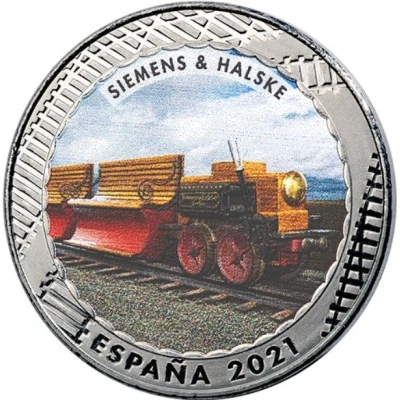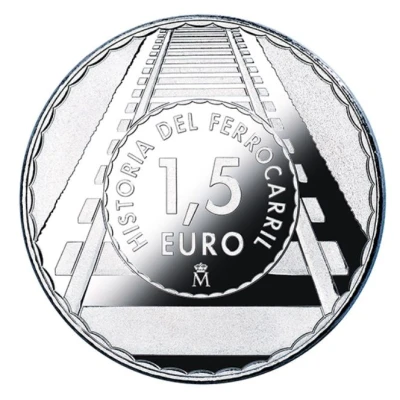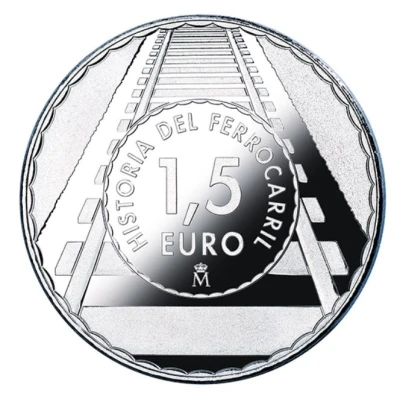


© Real Casa de la Moneda
1.5 Euro Siemens and Halske
2021 year| Copper-nickel (75% copper, 25% nickel) | 15 g | 33 mm |
| Issuer | Spain |
|---|---|
| King | Felipe VI (2014-date) |
| Type | Non-circulating coin |
| Year | 2021 |
| Value | 1.5 Euro 1.50 EUR = USD 1.65 |
| Currency | Euro (2002-date) |
| Composition | Copper-nickel (75% copper, 25% nickel) |
| Weight | 15 g |
| Diameter | 33 mm |
| Shape | Round |
| Technique | Milled, Coloured |
| Orientation | Medal alignment ↑↑ |
| Updated | 2024-10-07 |
| Numista | N#314705 |
|---|---|
| Rarity index | 91% |
Reverse
Series and face value inside a central circle. Outside the central circle, an image of a railway track.
Script: Latin
Lettering:
HISTORIA DEL FERROCARRIL
1,5 EURO
M
Translation: History of railways
Edge
Plain
Comment
For the year 2021, since the European Year of the Rail and the 80th Anniversary of Renfe are celebrated, the FNMT-RCM issues a collection of 20 coins dedicated to the History of the Railways. This series reproduces a selection of trains and locomotives that have been relevant throughout its history.Siemens & Halske: In the last 30 years of the nineteenth century, the Second Technological Revolution led to the development of electricity as an alternative source of power to coal. Various initiatives to apply electricity to the railway were quick to make an appearance as it afforded the advantages of reducing the discomfort suffered by steam train passengers; it was better adapted to local travel; and it provided more power to overcome the more uneven sections of terrain on the networks.
From the technological point of view, this new venture was ushered in with the invention of the dynamo by Zenobe Gramme and Werner Siemens in the 1860s. In 1881, Siemens & Halske set out to build a first vehicle able to travel along a 2.45 km road on the outskirts of Berlin. However, after a number of further trials, the German company finally presented its electric locomotive the Original B at the Berlin Industrial Exposition in 1879. The first 18 passengers were seated back-to-back in small wagons. The locomotive was fuelled by a 150 V continuous current provided by a central conductor rail and a liquid resistance controller. Its 5 hp engine was connected to the driving wheels by gears and its top speed was 7 km/h.
In comparison with the locomotives produced in later years, this first attempt was clearly an extremely simple initial prototype which would, nevertheless, change the history of the railway. In fact, it was put to practical use straightaway when Siemens & Halske built a 2.4 km-long track from Berlin to Lichterfelde, a suburb of the German capital. It became operative in 1881.
The Siemens Original B locomotive forms an important part of Europe’s railway heritage and as such, is kept and displayed at the Museum of Science and Technology in Munich (Germany).
Interesting fact
The 1.5 Euro Siemens and Halske coin from Spain features an innovative design that incorporates a built-in RFID chip, making it the first coin in the world to use this technology.
Price
| Date | Mintage | VG | F | VF | XF | AU | UNC |
|---|---|---|---|---|---|---|---|
| 2021 M | 7000 | - | - | - | - | - | - |
Values in the table are based on evaluations by sales realized on Internet platforms. They serve as an indication only for 1.5 Euro (Siemens and Halske) 2021 coin.



